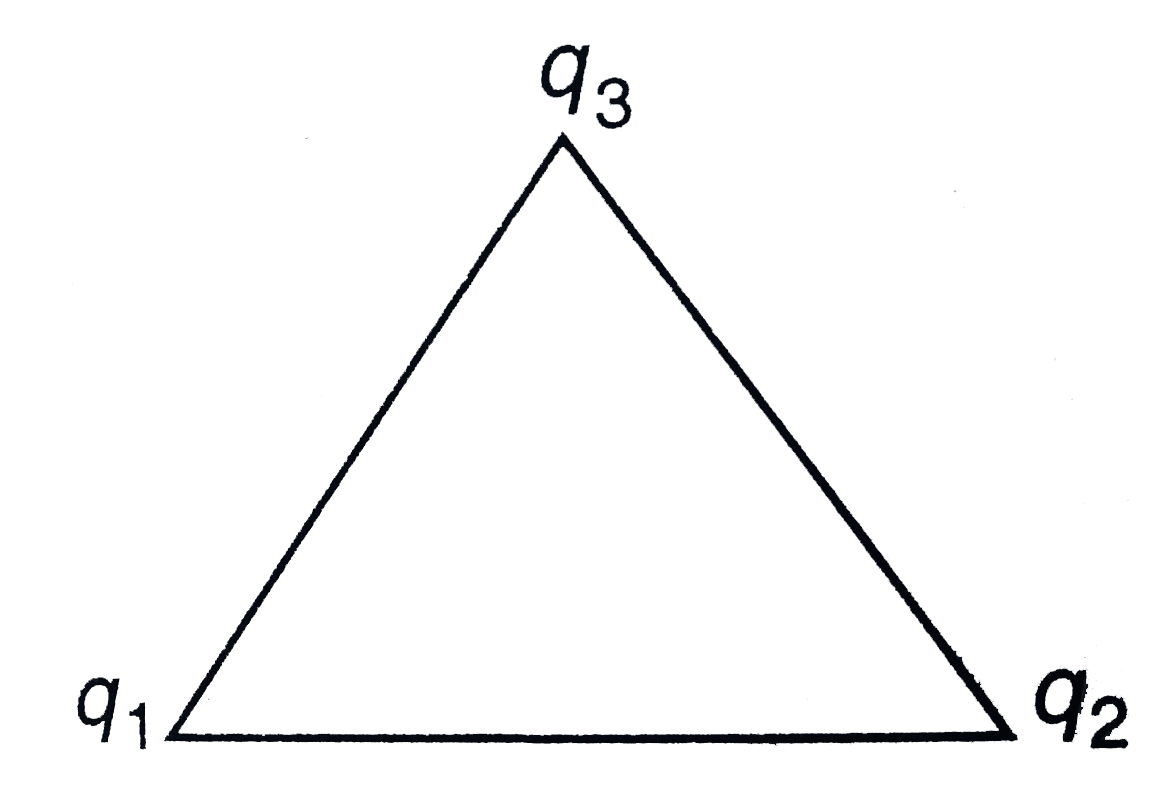The point charges −2q,−2q and +q are put on the vertices of an equilateral triangle of side a. Find the work done by some external force in increasing the separation to 2a (in joules).
14πε0.2q2a
negativee
zero
14πε0.3q2a
The correct Answer is:C
To find the work done by an external force in increasing the separation of the charges from a distance a to 2a, we will calculate the initial and final potential energy of the system of charges and then determine the work done based on the change in potential energy.
1. Identify the Charges and Their Positions:
We have three charges placed at the vertices of an equilateral triangle:
- Charge 1: Q1=−2q
- Charge 2: Q2=−2q
- Charge 3: Q3=+q
2. Calculate the Initial Potential Energy:
The initial separation between the charges is a. The potential energy U between two point charges is given by:
U=kQ1Q2r
where k is Coulomb's constant and r is the distance between the charges.
- Potential energy between Q1 and Q2:
U12=k(−2q)(−2q)a=k4q2a
- Potential energy between Q1 and Q3:
U13=k(−2q)(+q)a=−k2q2a
- Potential energy between Q2 and Q3:
U23=k(−2q)(+q)a=−k2q2a
Now, summing these potential energies gives the total initial potential energy Ui:
Ui=U12+U13+U23=k4q2a−k2q2a−k2q2a=0
3. Calculate the Final Potential Energy:
Now, we increase the separation to 2a. We will recalculate the potential energies with the new distance.
- Potential energy between Q1 and Q2:
U′12=k(−2q)(−2q)2a=k4q22a=k2q2a
- Potential energy between Q1 and Q3:
U′13=k(−2q)(+q)2a=−k2q22a=−kq2a
- Potential energy between Q2 and Q3:
U′23=k(−2q)(+q)2a=−k2q22a=−kq2a
Now, summing these potential energies gives the total final potential energy Uf:
Uf=U′12+U′13+U′23=k2q2a−kq2a−kq2a=0
4. Calculate the Work Done:
The work done W by the external force is equal to the change in potential energy:
W=Uf−Ui=0−0=0Joules
Conclusion:
The work done by the external force in increasing the separation of the charges from a to 2a is 0 Joules.
We have three charges placed at the vertices of an equilateral triangle:
- Charge 1: Q1=−2q
- Charge 2: Q2=−2q
- Charge 3: Q3=+q
The initial separation between the charges is a. The potential energy U between two point charges is given by:
U=kQ1Q2r
where k is Coulomb's constant and r is the distance between the charges.
U12=k(−2q)(−2q)a=k4q2a
U13=k(−2q)(+q)a=−k2q2a
U23=k(−2q)(+q)a=−k2q2a
Ui=U12+U13+U23=k4q2a−k2q2a−k2q2a=0
Now, we increase the separation to 2a. We will recalculate the potential energies with the new distance.
U′12=k(−2q)(−2q)2a=k4q22a=k2q2a
U′13=k(−2q)(+q)2a=−k2q22a=−kq2a
U′23=k(−2q)(+q)2a=−k2q22a=−kq2a
Uf=U′12+U′13+U′23=k2q2a−kq2a−kq2a=0
The work done W by the external force is equal to the change in potential energy:
W=Uf−Ui=0−0=0Joules
The work done by the external force in increasing the separation of the charges from a to 2a is 0 Joules.
Topper's Solved these Questions
- BOOK - DC PANDEY ENGLISHCHAPTER - ELECTROSTATICSEXERCISE - JEE Advanced44videos
ELECTROSTATICS
- BOOK - DC PANDEY ENGLISHCHAPTER - ELECTROSTATICSEXERCISE - Comprehension36videos
ELECTROSTATICS
- BOOK - DC PANDEY ENGLISHCHAPTER - ELASTICITYEXERCISE - Medical entrances s gallery21videos
ELASTICITY
- BOOK - DC PANDEY ENGLISHCHAPTER - EXPERIMENTSEXERCISE - Subjective15videos
EXPERIMENTS
Similar Questions
Knowledge Check
- Question 1 - Select One
Consider the charges q,q and -q placed at the vertices of an equilateral triangle of each side l. What is the force on each charge ?
Aq24√2πε0l2B−q24πε0l2Cq24πε0l2Dzero
Find the coordinates of the vertices of an equilateral triangle of side 2a as shown in Figure.
View SolutionThree pont charges q, q & - 2q placed, at the corners of equilateral triangle of side 'L ' Calculate work done by extemal force in moving all the charges far apart without acceleration
View SolutionThree point charges q are placed at three vertices of an equilateral triangle of side a. Find magnitude of electric force on any charge due to the other two.
View SolutionThree charges +q, +q and -2q are placed at the vertices of an equilareral triagle. What is the dipole moment of the system?
View SolutionThree equal charge Q are at the vertices of an equilateral triangle of side A. How much work is done (by an external angent ) in bringing them closser to an equilateral triangle of side A/2?
View SolutionThree charges +q, -q and +q are kept at the corners of an equilateral triangle of side d. Find the resultant electric force on a charge +q placed at the centroid O of the triangle.
View SolutionIf the point (0,0),(2,2√3), and (p,q) are the vertices of an equilateral triangle, then (p ,q) is
View Solution


